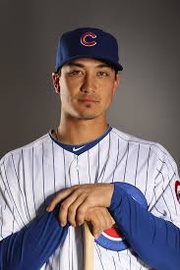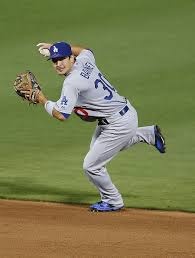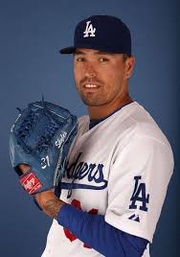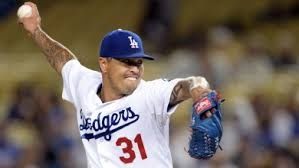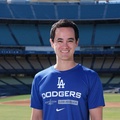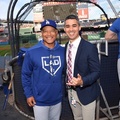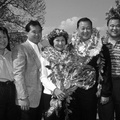Sitting in the upper deck overlooking right field at AT&T Park in San Francisco for the first game of the Dodgers-Giants series in September, I was feeling pretty low. As part of the biennial Komai Family Reunion this year, our Northern California relatives had arranged to get tickets to this historic rivalry and even chartered a bus for us to attend the game as a group. Not surprisingly, most of the Northern relatives wore Giants’ gear. A few of us from the south, like my brother and his wife, were audacious enough to wear Dodger Blue. Which is how we Dodger fans were feeling near the end of the game.
Madison Bumgarner, the Giants’ ace this year, was shutting out the Dodgers, while the Giants ran over L.A. starter Hyun-jin Ryu, who only lasted an inning. With the game winding down and the Giants winning, 6‐0, the Dodgers had pretty much thrown in the towel. Kevin Correia, a long reliever and spot starter (translation: he only pitches when the Dodgers don’t have anyone else available), was on the mound when the Giants sent up Travis Ishikawa to pinch hit with two runners on base. Given the situation and the fact that Ishikawa is one of a handful of Japanese Americans playing in the majors, I blurted out, “He might as well hit a home run.”
Next pitch: blammo! Ishikawa hit a towering drive into the San Francisco Bay. The crowd went wild. Our Northern relatives rejoiced. Nine to nothing (which is how the game ended). My sister gave me the stink eye. I shrugged. It certainly did not affect the outcome and in general, I root for any JA to do well, especially in sports. If the game had been close, I would have wanted Ishikawa to strikeout, but in this instance, losing 9–0 versus 6–0 is really the same thing.
(As a consolation to we Dodger fans, our side won the next day, 17 to 0, allowing our branch of the family to celebrate at the family reunion dinner the next night. Then Clayton Kershaw took care of the Giants on Sunday. The South shall rise again!)
This is actually a golden age of Japanese American baseball players. Okay, make that a bronze age, but there are a half dozen or so individuals floating around major league rosters like Ishikawa. It is important to appreciate how difficult it is to reach the highest levels of professional sports. While Hideo Nomo opened the doors for top players from Japan to play in the United States, few JAs ever get to play in the major leagues and fewer still make any impact. The Dodgers have two players, Brandon League and Darwin Barney, who are Japanese Americans. Like Ishikawa, they are not regulars and rarely see action when the game is on the line.
In 2014, Kurt Suzuki is undoubtedly the best known and most accomplished of this group, but even he is not a household name. Born and raised in Hawaii (like so many of the best JA athletes), Suzuki played collegiate ball at Cal State Fullerton and sparked their run to the NCAA baseball title in 2004 when he delivered a clutch two-RBI single against Texas. He earned the Johnny Bench Award as best collegiate catcher that year and was drafted by the Athletics.
After making the slow climb through the minor leagues (a common path for the current group of JAs), Suzuki broke into the majors in 2007 and progressed enough to become the A’s starting catcher in 2008. He had his best year in 2009 and signed a four-year deal worth reportedly more than $16 million. But, like most catchers, he got hurt and his hitting tailed off so he was sent to the Washington Nationals and was a platoon player. After a brief return to the A’s, he signed with Twins this year and had his best season, making the All Star team.
Suzuki is the exception. Mostly, Japanese American players are reserves. Since my days as the sports editor of The Rafu Shimpo, I have instinctively scanned the box scores for Japanese Americans. Names like Lenn Sakata (Milwaukee, Baltimore) and Don Wakamatsu (Chicago White Sox) would pop up occasionally, but neither of them were starters, let alone stars. Atlee Hammaker was an All-Star for the Giants in the 1980s (who famously gave up the gopher ball to Fred Lynn for the first grand slam in All-Star Game history), but arm trouble plagued his 14-year career.
Travis Takashi Ishikawa fits the current JA baseball mode. A star on his high school team in Federal Way, Washington, he was drafted by the Giants, but struggled to earn a regular spot on their roster. At six-foot, three inches tall and 220 pounds, he doesn’t lack for power (as seen by his home run into McCovey Cove) and is a good fielder, but can’t hit consistently enough to stay in the line-up. After playing on the Giants’ 2010 World Series championship team, he moved to the Brewers, Orioles, Yankees (for proverbial cup of coffee), White Sox, and the Pirates. Released this August, he signed with the Giants’ minor league club before being called up in time to hit his impressive (but not extremely meaningful) home run. A Yonsei, Ishikawa’s great-grandfather came to America to work on the railroads and his grandparents were incarcerated in Amache, Colorado during the war.
I heard a podcast done in the minor leagues with Ishikawa and the interviewer noted that Ishikawa drew a crucial walk against Atlanta in the 2010 play-offs. The Giants rallied to win that game and the series and eventually won the World Series. I suppose rabid Giant fans remember that walk. As a Dodger fan, I was there for Kirk Gibson’s miraculous home run to beat the Oakland A’s in Game 1 of the 1988 World Series. But, he never would have come to bat if Mike Davis had not drawn a walk against Hall of Fame reliever Dennis Eckersley, setting up Gibson’s heroics. For role players, this is the best-case scenario for lasting fame, contributing during a crucial game.
Walks are important in baseball (note the fact that on-base percentage is considered an essential statistics in modern baseball), but it is hardly a dynamic play. While loyal Giant fans may always remember Ishikawa fondly, I think nothing can compare with the one play Dave Roberts made for the Boston Red Sox in the 2004 American League play-offs. Roberts, who was born in Naha, Okinawa, to a retired Marine and a Japanese mother, should be recognizable to Southern California baseball fans, since he grew up in Vista, played at UCLA, and later for the Dodgers. Like Ishikawa, he bounced around, spending time with the Indians, Red Sox, Padres, and Giants before retiring. He is a coach with the Padres now.
Ask any Red Sox fans about “The Steal” and they will remember Dave Roberts. In 2004, the Red Sox were playing their hated rivals, the Yankees, in the American League Championship Series. The Yankees won the first three games and most Red Sox fans felt the Curse of the Bambino (Babe Ruth, who the Red Sox sold to the Yankees for cash) was at work again. Losing 4 to 3 in the 9th inning, the Red Sox were up against the Yankees’ Mariano Rivera, maybe the greatest relief pitcher of all time. But Kevin Millar drew a walk (there it is!) and Roberts, who stole almost 200 bases between 2002 and 2006, was sent in to pinch run. Everyone knew why Roberts was in the game, especially Rivera, who almost picked him off. But Roberts then stole second and when Bill Mueller cracked a single, Roberts came home with the tying run. The Red Sox went on to win in 12 innings and then won the next three games. They cruised to their first World Series title in almost 90 years.
I will bet you that Red Sox fans from this era will never forget Dave Roberts. Some Giant fans will always remember Ishikawa. Will Dodger fans remember League or Barney? It is possible, if not likely. First, the Dodgers have to win a couple of play-off series and get to the World Series, something they have not done since Gibson hit his home run. Second, either Barney and/or League would have to be put in a crucial situation and come through. Right now, that doesn’t seem probable. To put this in context, Roberts, for all his daring, never got into a game in the 2004 World Series.
Darwin James Kanane Barney, like Ishikawa, is an excellent fielder, but has not hit enough to remain a starter. He led his Southridge High School in Beaverton, Oregon, to the state championship and then played for Oregon State, which won back-to-back NCAA baseball titles in 2006 and 2007. Drafted by the Cubs in 2007, Barney, again like Ishikawa, had trouble staying on the major league roster until 2011. In 2012 as the Cubs’ starting second baseman, he won the Gold Glove, made only two errors, and had 141 consecutive errorless games, which tied a record. But he got hurt in 2013 and then hit only .208. He was hitting just .230 this year when the Cubs released him. The Dodgers picked him as a defensive reserve, but unless Dee Gordon gets injured, it’s hard to see where his playing time will come from in the post-season.
Barney, whose maternal grandfather is Japanese and maternal grandmother is Korean and, like Suzuki, has family in Hawaii, did have a terrific game in Atlanta at the end of August. He got to start since Gordon had been slumping. He made two superb defensive plays, including tracking down a pop fly in no-man’s land in right-center field and then plugging the hole between 1st and 2nd on a grounder and throwing out a speedy runner. He also drove in a run with his first hit as a Dodger and then took advantage of an error by the Atlanta shortstop to hustle all the way to second. On third base with two outs, Barney raced home when a ball bounced a few feet away from the catcher.
Barney is clearly athletic and can run (although he is not a base stealer like Roberts) and has great range in the field. But he has no power and his batting average is too low to be an everyday player. He played shortstop in college, but he has a second baseman’s arm, which means he is unlikely to be put in as a defensive replacement for Hanley Ramirez (who is not a very good shortstop, but a potentially great hitter). He has made a series of outstanding plays at second base, including the last out against the Giants to clinch the division.
Brandon Paul League, another Yonsei whose maternal great-grandparents came from Fukuoka, had, maybe, the most promise. He attended St. Louis School in Honolulu and was good enough to be drafted by Toronto in 2001. Called up in 2004, he showed promise as a reliever, but one story I read said that he was encouraged to bulk up and do weight training, which threw off his delivery. The Blue Jays traded him to Seattle in 2009 and in 2011, he became the closer and had his best year. He saved 37 games and was an All Star. But his control became an issue the following year and ended up with the Dodgers in 2012, who were desperate for a closer.
Unfortunately, League was not the guy. In 2013, he gave up 69 hits and walked 15 in only 54 innings. Even though he saved 14 games, his ERA was 5.30, and the Dodgers went back to Kenley Jansen, a former catcher, whose status was uncertain due to heart issues in 2012. Jansen has been superb and League has continued to struggle with his control. To the Dodgers’ credit, they have worked patiently with League, trying to build up his confidence in middle relief and occasional set-up. League has one more year on his contract, so I expect, barring a trade, he may get an opportunity to become the regular set-up reliever in 2015 since Brian Wilson has not been reliable this year.
Will Barney, League, or Ishikawa have a big moment? Only time will tell, but I, for one, will be watching.
© 2014 Chris Komai




